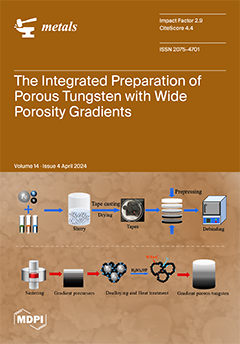Due to their exceptional electrical and thermal conductivity properties, high-purity copper (Cu-DHP) and copper alloys of similar composition, such as electrolytic tough-pitch (ETP), oxygen-free electronic (OFE) and oxygen-free (OF), have often been used in the manufacture of essential components for the electrical, electronic
[...] Read more.
Due to their exceptional electrical and thermal conductivity properties, high-purity copper (Cu-DHP) and copper alloys of similar composition, such as electrolytic tough-pitch (ETP), oxygen-free electronic (OFE) and oxygen-free (OF), have often been used in the manufacture of essential components for the electrical, electronic and power generation industries. Since these components are subject to cyclic loads in service, they can suffer progressive structural damage that causes failure due to fatigue. The purpose of this review is to examine the most relevant aspects of mechanical fatigue in Cu-DHP, ETP, OFE and OF. The impact of many factors on fatigue strength (S
e), including the frequency, temperature, chemical environment, grain size, metallurgical condition and load type, were analyzed and discussed. Stress–life (S-N) curves under zero mean stress (σ
m = 0) were found for high-cycle fatigue (HCF). For non-zero mean stress (σ
m ≠ 0), stress curves were based on a combination of Gerber, Soderberg and ASME elliptic failure criteria. Stress–life (S-N) curves were also developed to correlate fatigue strength (S
e) with stress amplitude (σ
a), yield strength (S
yp) and ultimate strength (S
ut). Finally, for low-cycle fatigue (LCF), strain–life (ε-N) curves that establish a relationship between the number of cycles to failure (N) and total strain amplitude (ε
plastic) were determined. Hence, this review, as well as the proposed curves, provide valuable information to understand fatigue failure for these types of materials.
Full article





